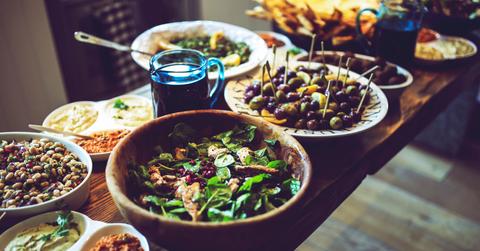Here's What You Need To Know About The Farm-To-Table Movement
The farm-to-table movement has grown wild. Everyone's doing it now, and the overuse of phrases like “farm-fresh,” “wild-caught,” and “farm-raised” make it awfully difficult to know what the buzzwords mean anymore—if anything at all.
Updated May 24 2019, 7:00 a.m. ET
The farm-to-table movement has grown wild.
Go back a century, and the phrase, along with “organic,” didn’t exist. Organic food was just food; farm-to-table was just the process of bringing food in from outside. Now, many of us are yearning to go back to our basics. But what does the "farm-to-table" label really mean?
Farm-to-table restaurants emphasize a close-knit, symbiotic relationship between farmers and chefs centered around seasonal, local food. Consumers have demonstrated a willingness en masse to pay more for food from a known location, where the animals run free and the produce is organic. Indeed, the farm-to-table catchphrase has exploded in the last half-decade.
It feels like everyone is doing it now, but not everyone is doing it well, and the overuse of phrases like “farm-fresh,” “wild-caught,” and “farm-raised” make it awfully difficult to even know what the buzzwords mean anymore—or if they mean anything at all. The high volume of farm-to-table restaurants popping up has left the lifestyle trend open to fraud, in part because of the haste by restaurants to hop on the bandwagon.
Let’s end the confusion. Here are the realities of actual farm-to-table food.
The food is local—and seasonal
For a restaurant to truly be farm-to-table, it has to be working in-season with nearby farms. That means no March apples in Northern New York, or November apricots in Arizona. And that means menus are going to change very regularly to reflect what’s ripe right now.
The produce is more nutritious
Some sources suggest that produce loses 30 percent of its nutrients within three days of harvest. Chew on that for a minute or two, and then consider what you might miss when buying fruits and vegetables in the grocery store, where it’s nothing for the produce to already be several weeks post-harvest by the time you buy it.
Menu phrases like “organic when possible” can be misleading
If a menu says everything is locally sourced when possible, assume the food is not locally sourced—and therefore, not farm-to-table. A responsible restaurant will highlight dishes that are specifically farm-to-table, and cite the farms each ingredient came from. “When possible” is a catch-all phrase that’s intentionally vague. And that’s the opposite of what farm-to-table is all about.
There is no middleman
For a venue to be farm-to-table, it must be buying food directly from the producer. A farmer’s market counts, but commercial vendors don’t.
There are known policies about how livestock is raised, slaughtered and processed
Any meat that’s sold commercially has to pass inspection and be processed by a federal- or state-sanctioned facility. The high fees for those certifications mean approved processors can be few and far between. And that means a lot of farmers end up shipping meat away for processing, kind of defeating the whole idea of buying local.
Farm-to-table doesn’t mean cruelty-free
Meat-eaters who choose local or farm-to-table meats may do so in an effort to feel more connected to the food chain, while supporting farms that provide better living conditions than their monolith counterparts.
For traditional cuts of chicken, pig and cow, small-scale farms, with lower animal counts, are likely to give the animals more space to graze. And that’s definitely a plus no matter how you slice it.
Farm-to-table restaurants are only as good as the farms supplying them
Successful farm-to-table restaurants will conduct regular site visits to their suppliers in order to nurture relationships with farmers, keep abreast of local fishing limits and regulations, and to check the conditions at a facility. Cramped or dirty conditions, poor drainage, and unkempt grounds can interfere with the rosy picture restaurateurs like to portray of where their food comes from.
Mindful consumers would be wise to take a look at those farms themselves, because it's nice to know your food is coming from a reputable source. But also because it shouldn't just be chefs who get to peek behind the proverbial curtain. Getting familiar with your food is a great way to learn all kinds of fascinating things about how food is grown, animals are raised, and what it takes to get both from farms to your table.
